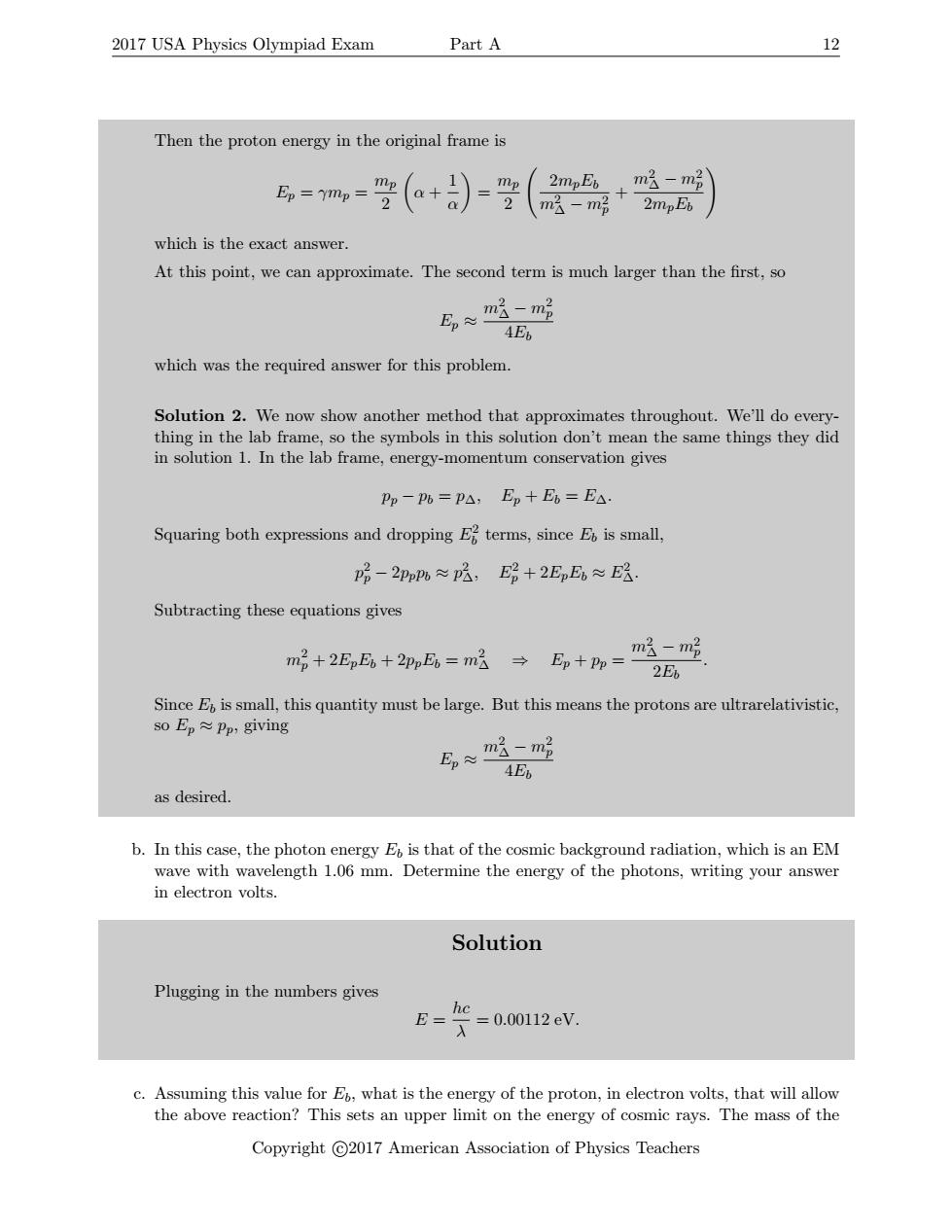正在加载图片...

2017 USA Physics Olympiad Exam Part A 12 Then the proton energy in the original frame is Ep =Ymp mp 2mpEb m2-m号 2 m-m 2mpEb which is the exact answer. At this point,we can approximate.The second term is much larger than the first,so m-m Ep≈一4E which was the required answer for this problem. Solution 2.We now show another method that approximates throughout.We'll do every- thing in the lab frame,so the symbols in this solution don't mean the same things they did in solution 1.In the lab frame,energy-momentum conservation gives Pp-Pb=PA,Ep+Eb=E△. Squaring both expressions and dropping E terms,since E is small, 2-2ppp%≈,E+2E,E6≈E层, Subtracting these equations gives m2 2EpEo+2ppEo m →Ep+pp= m-m呢 2Eb Since E is small,this quantity must be large.But this means the protons are ultrarelativistic, soEp≈Pp,giving Ep≈ m-m 4Eb as desired. b.In this case,the photon energy E is that of the cosmic background radiation,which is an EM wave with wavelength 1.06 mm.Determine the energy of the photons,writing your answer in electron volts. Solution Plugging in the numbers gives hc=0.00112eV. E二 c.Assuming this value for Eo,what is the energy of the proton,in electron volts,that will allow the above reaction?This sets an upper limit on the energy of cosmic rays.The mass of the Copyright C2017 American Association of Physics Teachers2017 USA Physics Olympiad Exam Part A 12 Then the proton energy in the original frame is Ep = γmp = mp 2 α + 1 α = mp 2 2mpEb m2 ∆ − m2 p + m2 ∆ − m2 p 2mpEb ! which is the exact answer. At this point, we can approximate. The second term is much larger than the first, so Ep ≈ m2 ∆ − m2 p 4Eb which was the required answer for this problem. Solution 2. We now show another method that approximates throughout. We’ll do everything in the lab frame, so the symbols in this solution don’t mean the same things they did in solution 1. In the lab frame, energy-momentum conservation gives pp − pb = p∆, Ep + Eb = E∆. Squaring both expressions and dropping E2 b terms, since Eb is small, p 2 p − 2pppb ≈ p 2 ∆, E2 p + 2EpEb ≈ E 2 ∆. Subtracting these equations gives m2 p + 2EpEb + 2ppEb = m2 ∆ ⇒ Ep + pp = m2 ∆ − m2 p 2Eb . Since Eb is small, this quantity must be large. But this means the protons are ultrarelativistic, so Ep ≈ pp, giving Ep ≈ m2 ∆ − m2 p 4Eb as desired. b. In this case, the photon energy Eb is that of the cosmic background radiation, which is an EM wave with wavelength 1.06 mm. Determine the energy of the photons, writing your answer in electron volts. Solution Plugging in the numbers gives E = hc λ = 0.00112 eV. c. Assuming this value for Eb, what is the energy of the proton, in electron volts, that will allow the above reaction? This sets an upper limit on the energy of cosmic rays. The mass of the Copyright c 2017 American Association of Physics Teachers